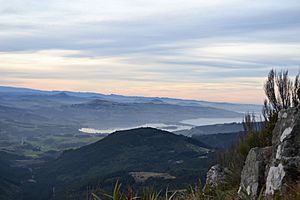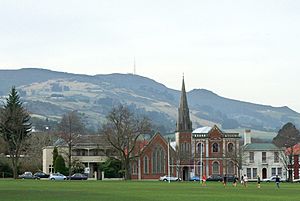Mount Cargill facts for kids

Mount Cargill, also called Kapukataumahaka in Māori, is a big hill formed by an old volcano. It stands out in the northern sky of Dunedin, New Zealand.
The mountain got its name from Captain William Cargill. He was an important early leader in the Otago area. An old Māori story says the mountain looks like a famous warrior lying down. If you look from Dunedin, Mount Cargill and Buttar's Peak together really do look like a person resting. Buttar's Peak is like the head, and Mount Cargill is the body.
From the very top of Mount Cargill, you can see amazing views of Dunedin and the land around it. This makes it a popular spot, even though it's a bit tricky to get to. There's a rough road that goes up to the top. Many people also enjoy walking on the tracks that climb up the sides of the mountain.
At the very top of Mount Cargill, there's a special station with a tall mast. This is called the Mount Cargill Transmitting Station. This mast is the tallest thing built by people in Dunedin!
Contents
Exploring Mount Cargill's Location
Mount Cargill is about 15 kilometers (9 miles) north of Dunedin's city center. It really stands out in the northern view of the city. The mountain reaches a height of 676 meters (2,218 feet). To the north and east of Mount Cargill, you'll find other smaller peaks. These include Mount Zion, Mount Holmes, and the well-known Buttar's Peak.
Getting to the Top
You can drive up a rough road to the summit. This road starts at the end of Pine Hill Road. There are also several walking paths that lead to the top. One popular walk is about 4 kilometers (2.5 miles) long. It starts from Bethune's Gully in North East Valley, which is at the northern edge of Dunedin.
Another path is about 6 kilometers (3.7 miles) long. This one goes through Graham's Bush and begins in Sawyers Bay, close to Port Chalmers. These paths take you through forests that are growing back. You'll also see cool rock formations from the old volcano. The last part of the climb is quite steep, just below the very top.
Cool Sights on the Way
As you walk the tracks, you'll see two interesting things. One is a cool rock formation called the Organ Pipes. These are tall, straight columns of rock that look like organ pipes. You can find similar rocks in other parts of Dunedin too.
The second interesting spot is a small, misty forest on the upper slopes. Even though it's not a tropical cloud forest, it feels very similar. It has lots of moss and ferns growing under a thick, low tree cover. This special forest is protected in a reserve that covers about 1.8 square kilometers (0.7 square miles). This area includes the mountain peak and some smaller hills. The walking tracks are easy to follow, but they are steep. Always be careful, as the weather on Mount Cargill can change very quickly and without warning.
Amazing Views from the Summit
Mount Cargill is one of the highest points around Dunedin, just like Flagstaff. Because it's so high, it's a fantastic place to look out from. From the top, you can see all of Dunedin city. You can also see a lot of the countryside and much of Otago's coastline. This view stretches from Shag Point near Palmerston all the way to Nugget Point in The Catlins. The view of the Otago Peninsula and Otago Harbour is especially great. You can see the entire length of the harbor from the summit.
How Mount Cargill Was Formed
Mount Cargill and the smaller hills nearby are some of the newest parts of a huge, old volcano called the Dunedin Volcano. This volcano was active between 16 and 10 million years ago. The very top of Mount Cargill is made of a type of rock called nepheline phonolite. This rock pushed up through older volcanic ash and lava flows. This suggests that the mountain first formed as a cone of ash. Later, the nepheline phonolite rock plugged up the volcano's opening.
Buttar's Peak and Mount Zion are similar, but smaller, rock formations. Mount Holmes is a more distinct plug of rock. This is where you can see the cool Organ Pipes, which are made of columnar jointed basalt.


The Mount Cargill Transmitting Station
The Mount Cargill transmitting station sits right on top of the mountain. It sends out television and FM radio signals to Dunedin and the eastern Otago area. This station was finished in 1970. It started broadcasting the television channel DNTV2 (which is now part of TVNZ 1). It took over from an older station at Highcliff. The station has a mast that is 104.6 meters (343 feet) tall. This makes it the tallest structure in Dunedin!
What the Station Broadcasts
Many television and radio stations use the Mount Cargill station to send out their signals:
| Type | Station Name | Frequency |
|---|---|---|
| Television | World TV digital | 530.0 MHz |
| Television | Sky digital | 546.0 MHz |
| Television | MediaWorks digital | 562.0 MHz |
| Television | TVNZ digital | 578.0 MHz |
| Television | Kordia digital | 594.0 MHz |
| Television | Māori Television digital | 610.0 MHz |
| Radio | ZM | 88.6 MHz |
| Radio | The Hits | 89.4 MHz |
| Radio | The Sound | 90.2 MHz |
| Radio | Radio One | 91.0 MHz |
| Radio | The Edge | 91.8 MHz |
| Radio | RNZ Concert | 92.6 MHz |
| Radio | The Rock | 93.4 MHz |
| Radio | Life FM | 94.2 MHz |
| Radio | Radio Hauraki | 95.8 MHz |
| Radio | Magic Talk | 96.6 MHz |
| Radio | More FM | 97.4 MHz |
| Radio | The Breeze | 98.2 MHz |
| Radio | Magic Music | 99.8 MHz |
| Radio | More FM | 100.6 MHz |
| Radio | Coast | 104.6 MHz |
| Radio | Otago Access Radio | 105.4 MHz |
| Radio | Flava | 106.2 MHz |




